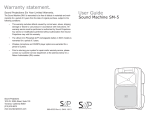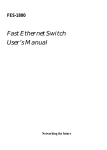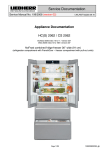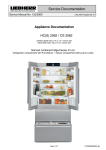Download 1. introduction to suunto smartbelt 2. getting started with
Transcript
1. INTRODUCTION TO SUUNTO SMARTBELT Suunto SmartBelt is a wireless heart rate transmitter belt that also records the data of a training session on an integrated memory chip. The data can then be downloaded from the belt to your PC via the USB-equipped docking station for further analysis. When heart rate data is transmitted, brief breaks in transmission can sometimes occur – if another person or object comes between the transmitter belt and receiver, or you enter water for example. Because Suunto SmartBelt records as well as transmits the heart rate data, you can be sure that the information measured is complete and uninterrupted, enabling extremely accurate post-training analysis. This also means that, unlike conventional heart rate transmitter belts, Suunto SmartBelt can be used in water-based activities. When Suunto SmartBelt is used in conjunction with Suunto software, it enables you to view your heart rate data in graphical form and analyze it in greater detail. Suunto SmartBelt can also be used with Suunto Team Pod, Suunto PC Pod, and Suunto t-series wristop computers. Active sports people and anyone involved in physical training programs will find Suunto SmartBelt an invaluable tool for heart rate analysis. 2. GETTING STARTED WITH SUUNTO SMARTBELT This section contains all the information you need to get started with your Suunto SmartBelt, including putting on the Smartbelt, activating, and recording. Suunto SmartBelt is comfortable and straightforward to use. The user interface consists of a color LED and a beeper that make the Suunto SmartBelt’s signals easy to understand and respond to. A green LED indicates that everything is working normally, a orange LED indicates that the memory is low or full, and a red LED indicates that the battery is low or empty. PUTTING ON SUUNTO SMARTBELT To get the best results from your Suunto SmartBelt, it is important that you wear it correctly. To put it on, just follow the simple steps below: 1. Put on your HR transmitter belt and ensure it fits snugly against your chest. 2. Ensure the electrodes of the transmitter belt are lightly wet. NOTE: We recommend that you wear the transmitter belt against your bare skin to ensure flawless operation WARNING People who have a pacemaker, defibrillator, or other implanted electronic device use the transmitter belt at their own risk. Before starting the initial use of the transmitter belt, we recommend an exercise test under a doctor’s supervision. This will ensure the safety and reliability of the pacemaker and transmitter belt when being used simultaneously. Exercise may include some risk, especially for those who have been sedentary. We strongly advise you to consult your doctor prior to beginning a regular exercise program. 4 ACTIVATING AND RECORDING Suunto SmartBelt is activated and starts recording automatically when you put it on, and this is indicated by a short beep and a short green flash. After activation, the green light flashes every 4 seconds to show that the device is measuring and recording your heart rate. If the beep and green flash do not occur when you have put the Suunto SmartBelt on, make sure that the belt fits snugly and that the electrodes are wet. If the orange or red light flashes, the memory or battery is low. Refer to the section “Errors and warnings”. While training, Suunto SmartBelt will alert you if you reach your predefined upper or lower heart rate limits with a long beep and a long green flash. See the section “Customizing your Suunto SmartBelt” for information on setting the upper and lower heart rate limits. After training, the device will automaticaly stop recording your heart rate data when you take off the Smartbelt. This is confirmed by 3 short beeps and 3 short green flashes. After 60 seconds, the device will go into sleep mode, which is indicated by 3 more short beeps and 3 more short green flashes. 5 3. USING SUUNTO SMARTBELT WITH OTHER SUUNTO DEVICES Suunto SmartBelt’s dual functionality of recording and transmitting is maximized when it is used in conjunction with Suunto PC software and other Suunto devices. The optional software and devices enable both real-time analysis, through viewing the data as it is being transmitted, and deeper analysis after the training has finished TRANSMITTING AND ANALYZING DATA Suunto SmartBelt Suunto Smart Belt can be used for real-time heart rate transmission to a number of ANT-enabled devices. The transmitted data can be analyzed in more detail using Suunto PC software. Suunto PC POD Suunto Team Pod Receives real-time data from the HR belts of 1–3 athletes. Receives real-time data from the HR belts of up to 30 athletes. Suunto t-series wristop computers Receives real-time data from one HR belt. 1 2 3 4 5 6 7 Suunto Monitor Displays and records the HR data received by the Team POD and the PC POD. Suunto Training/Team Manager Stores athlete profiles and analyses logs recorded by Suunto Monitor and Suunto t-series wristop computers. RECORDING AND ANALYZING DATA Suunto SmartBelt Suunto SmartBelt also records your heart rate data. It can then be transferred to your PC using the included Suunto SmartBelt Docking Station. The extremely accurate data can then be analyzed in more detail using Suunto PC software. Suunto Training/Team Manager Stores athlete profiles and analyses logs recorded by Suunto SmartBelt. For further information, please refer to the User’s Guides of individual devices. 6 When using Suunto SmartBelt with Suunto PC Pod or a Suunto Team Pod, it is good to be aware that factors such as humidity, obstacles like trees, other athletes, and walls can interfere with transmission from the HR belt. As a 2.4 GHz signal does not go through water, and therefore also the human body, the transmission from the HR belt is hindered if the monitored athlete is facing away from the Suunto Team Pod or Suunto PC Pod, so there may be disruptions in the recording of the HR signal. These factors do not affect the quality of the recorded heart rate data if the Suunto SmartBelts own memory is in use. Please refer to the Users’s Guides of the Suunto Team Pod and Suunto PC Pod for further information on operating range and positioning of the Pods. USING WITH SUUNTO t-SERIES WRISTOP COMPUTERS When Suunto SmartBelt has been successfully paired with a Suunto t-series wristop computer, and is sending data to the wristop computer, the LED will emit a green flash every 4 seconds. If the Suunto SmartBelt does not flash when paired with a Suunto t-series wristop computer, the belt is not sending the heart rate data. 1 green every 4 seconds when paired with a Suunto t6: sending data 4. USING WITH A PC When you connect your Suunto SmartBelt to a PC, you can analyze the recorded data in more detail and customize the settings of the device. CONNECTING TO THE DOCKING STATION Connecting your Suunto SmartBelt to a PC is simple. First, connect the docking station to your PC’s USB port using the included USB cable. Then place your Suunto SmartBelt into the docking station as shown in the figure below. 7 DOWNLOADING AND ANALYZING DATA The heart rate data recorded by your Suunto SmartBelt can be transferred to your PC using the USB-equipped docking station. A short beep and a short green flash indicate that the Suunto SmartBelt has been connected to your PC’s USB port via the docking station. 1 short green 1 short connected to PC Use the PC software to start transfering the data from the Suunto SmartBelt. Two short orange flashes every 4 seconds indicate that data transfer is underway, while a short beep and a short orange flash indicate that the data tranfer has been completed successfully. 2 short orange every 4 seconds data transfer under way 1 short orange 1 short data transfer complete You can then view the data in graphical form and analyze it in more detail using Suunto Team Manager or Suunto Training Manager PC software. When you are finished, 3 short beeps and 3 short green flahes indicate when the cable has been removed. CUSTOMIZING YOUR SUUNTO SMARTBELT You can use your PC to cutomize your Suunto SmartBelt. You can make the following adjustments to the belt’s functionality from the PC interface: • • • • 8 Define your upper and lower heart rate limits Switch the heart rate limit alert sounds on or off Switch the belts own memory on or off Define the percentage of free memory available before the belt gives a lowmemory warning 5. ERRORS AND WARNINGS Suunto SmartBelt communicates errors and warnings with medium-length orange and red flashes and medium-length beeps. If the battery is low, but the Suunto SmartBelt is still reading your heart rate, 2 medium-length beeps and 2 medium-length red flashes, followed by a red flash every 4 seconds, will indicate that you should replace the battery. If the battery is too low to operate, the device will switch to sleep mode, and 2 medium-length beeps and 2 medium-length red flashes will indicate that you should replace the battery. If the memory is low, a medium-length beep and medium-length orange flash, followed by an orange flash every 4 seconds, will indicate that you should download your data to your PC and empty the belt’s memory. If the memory is full, measuring ends and the device switches to sleep mode. This is indicated by a medium-length beep and medium-length orange flash. You should then download your data to your PC and empty the belt’s memory. If, during training, Suunto SmartBelt no longer detects your heart rate, it will alert you by a beep and a flash after 30 seconds. If, after a further minute, the device still receives no data, it will stop recording and go into sleep mode, which is indicated by a beep and a flash. 9 REPLACING THE BATTERY The transmitter belt operates on a 3-Volt lithium cell, type: CR 2032. The average expected battery life of the transmitter belt is 300 hours of use in ideal operating temperatures. To replace the battery: 1. Insert a coin into the slot located on the battery compartment cover on the backside of the transmitter belt. 2. Turn the coin counterclockwise until it is aligned with the open position marker, or even slightly further for easy opening. 3. Remove the battery compartment cover. Ensure that the O ring and all surfaces are clean and dry. Do not stretch the O ring. 4. Carefully remove the old battery. 5. Place the new battery into the battery compartment with the positive side facing up. A short beep and a short green flash indicate that the new battery has been installed successfully. 1 short green 1 short battery installed successfully NOTE: If the SmartBelt has been stored in a cold place, it may give a low battery warning even though the battery has enough power left. In such cases, allow the device to warm up in room temperature for 15 minutes and then activate it again. NOTE: Suunto recommends that the battery cover and the O ring are changed simultaneously with the battery to ensure that the transmitter remains clean and water resistant. Replacement covers are available with replacement batteries. 6. INSTALLING SUUNTO SOFTWARE INSTALLING THE SOFTWARE 1. Insert the Suunto software CD-ROM into the drive. 2. Wait for the installation to begin and follow the installation instructions. NOTE: If the installation does not start automatically, click Start --> Run, and type D:\setup.exe. INSTALLING THE USB DRIVERS These instructions assume that you are installing Suunto Sports Instrument drivers on a clean system, i.e. one that does not already contain any Suunto Sports Instrument drivers. If this is not the case, uninstall the previously installed drivers before proceeding with the installation. INSTALLING THE SUUNTO SPORTS INSTRUMENT WINDOWS 98/ 2000/XP 1. Insert the Suunto software CD-ROM into the drive. 2. Attach the Suunto Sports Instrument PC interface cable to your computer's USB port. The Wizard is automatically activated. 3. Click Next. 4. Search for a suitable driver on your system and click Next. If you are using 10 Windows XP, select Install the software automatically in the Wizard and click Next. If an installation warning is displayed, click Continue anyway. 5. Browse for the driver folder on the CD-ROM and click Next. 6. Click Next to install the located driver. 7. Click Finish to end the installation. 7. TECHNICAL SPECIFICATIONS • • • • • • Water resistance: 20 m / 66 ft Weight: 61g Frequency: 2.465 GHz Suunto ANT compatible Transmission range: up to 10 meters User-replaceable battery CR2032 Memory capacity: Approx 1 million heart beats. (Approx 5.7 days with a 120 bpm heart rate, or 13 days with a 60 bpm heart rate 8. INTELLECTUAL PROPERTY COPYRIGHT This publication and its contents are proprietary to Suunto Oy and are intended solely for the use of its clients to obtain knowledge and information regarding the operation of Suunto products. Its contents shall not be used or distributed for any other purpose and/or otherwise communicated, disclosed or reproduced without the prior written consent of Suunto Oy. While we have taken great care to ensure that information contained in this documentation is both comprehensive and accurate, no warranty of accuracy is expressed or implied. Its content is subject to change at any time without notice. The latest version of this documentation can always be downloaded from www.suunto.com. © Suunto Oy 12/2005 TRADEMARK Suunto and Replacing Luck are registered trademarks of Suunto Oy. Suunto t6 and other Suunto product, feature, and content names are registered or unregistered trademarks of Suunto Oy. Other product and company names are trademarks of their respective owners. 9. DISCLAIMERS USER’S RESPONSIBILITY This instrument is intended for recreational use only. Suunto Team Pod must not be substituted for obtaining measurements that require professional or industrial precision. CE The CE mark is used to mark conformity with the European Union EMC directives 89/336/EEC and 99/5/EEC. FCC COMPLIANCE This device complies with Part 15 of the FCC limits for class B digital devices. This equipment generates, uses, and can radiate radio frequency energy and, if not installed or used in accordance with the instructions, may cause harmful interference to radio communications. There is no guarantee that interference will not occur in a particular instance. If this equipment does cause harmful interference to other equipment, try to correct the problem by relocating the equipment. Consult an authorized Suunto representative or other qualified service technician if you cannot correct the problem. Operation is subject to the following conditions: (1) This device cannot cause harmful interference. (2) This device must accept any interference received, including interference that may cause undesired operation. Repairs should be made by authorized Suunto service personnel. Unauthorized repairs will void warranty. Tested to comply with FCC standards. For home or office use. FCC WARNING: Changes or modifications not expressly approved by Suunto Oy could void your authority to operate this device under FCC regulations. 11 LIMITS OF LIABILITY AND ISO 9001 COMPLIANCE If this product should fail due to defects in materials or workmanship, Suunto Oy will, at its sole option, repair or replace it with new or rebuilt parts, free of charge, for two (2) years from the date of its purchase. This warranty is only extended to the original purchaser and only covers failures due to defects in materials and workmanship that occur during normal use while in the period of the warranty. It does not cover battery, battery replacement, damage or failures resulting from accident, misuse, neglect, mishandling, alteration or modifications of the product, or any failure caused by operation of the product outside the scope of its published specifications, or any causes not covered by this warranty. There are no express warranties except as listed above. The client can exercise the right to repair under the warranty by contacting Suunto Oy’s Customer Service department to obtain a repair authorization. Suunto Oy and its subsidiaries shall in no event be liable for any incidental or consequential damages arising from the use of or inability to use the product. Suunto Oy and its subsidiaries do not assume any responsibility for losses or claims by third parties that may arise through the use of this device. Suunto's Quality Assurance System is certified by Det Norske Veritas to be ISO 9001 compliant in all Suunto Oy's operations (Quality Certificate No. 96-HELAQ-220). AFTER SALES SERVICE If a claim under warranty appears to be necessary, return the product, freight prepaid, to your Suunto representative who is responsible for having your product repaired or replaced. Include your name, address, proof of purchase and/or service registration card, as required in your country. The claim will be honored and the product repaired or replaced at no charge and returned in what your Suunto representative determines a reasonable amount of time, provided that all necessary parts are in stock. All repairs that are not covered under the terms of this warranty will be made at the owner's expense. This warranty is non-transferable from the original owner. You can locate your local Suunto representative at www.suunto.com. 10. DISPOSAL OF THE DEVICE Please dispose of the device in an appropriate way, treating it as electronic waste. Do not throw it in the garbage. If you wish, you may return the device to your nearest Suunto representative. 12




















